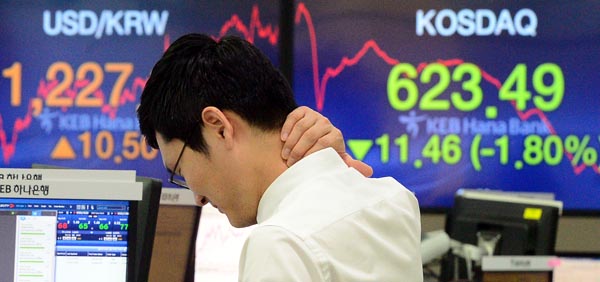Won value hits its lowest level since July 2010

The board at KEB Hana Bank’s headquarters in downtown Seoul on Wednesday shows the won closing at its lowest level in five years. [NEWSIS]
The deprecation largely resulted from investors seeking safer assets, including the U.S. dollar.
According to the Bank of Korea (BOK), the won’s exchange rate against the greenback ended at 1,227.1 won on Wednesday, up 10.5 won, or 8.63 percent, compared to the previous trading day. This was the largest fall the won value has seen since July 2, 2010, when the value of the Korean currency reached 1,228.5 won to the dollar. The exchange rate fell to as low as 1,228.4 won per dollar earlier in the day, but recovered in the afternoon.
The won deprecation was triggered by several factors, including falling crude prices, depreciation of the Chinese yuan and the possibility of an additional rate cut by the Korean central bank.
An overnight agreement between Saudi Arabia and Russia to freeze oil output instead of reducing it, as was expected by the market, also contributed to the additional lowering of crude prices.
The price of West Texas Intermediate oil slipped 0.4 percent on Tuesday local time to close at $29.04 per barrel, while that of Brent also dropped 1.21 percent compared to the previous day to close at $32.18 per barrel. This caused investors at home and abroad to turn away from riskier investments toward safer assets, including the greenback.
The yuan’s depreciation was another factor, which many economists say is part of the Chinese government’s efforts to keep exports high. It raised uncertainties in the global financial market and made investors favor the greenback’s appreciation. The People’s Bank of China on Wednesday announced a 0.16 percent cut to 6.5237 yuan per U.S. dollar, which was a one-month low. The rate cut was carried out for the second straight day and was the steepest cut since the 0.51 percent taken on Jan. 7.
Growing expectations that the BOK will lower the benchmark borrowing rate in the coming months was another factor.
“Easing is one the cards for the BOK, but a rate cut is contingent on a reduction in market volatility and clearer signs of softening growth,” Joseph Incalcaterra, an economist from HSBC, said. “We forecast a 25 basis-point cut to the main policy rate in the second quarter, alongside a downgrade to Korea’s 2016 growth forecast and new appointments to the BOK board.”
Analysts forecast the won will continue to depreciate for a while, as investors pull out money to put into the safer dollar, partially because of the BOK’s potential rate cut.
“Foreigners are likely to pull money out of the Korean market [contributing to the won’s depreciation] because they wouldn’t want to lose profits when exchanging from the won to the greenback,” said Ha Keon-hyeong, an analyst at Shinhan Financial Investment. “Investors will keep relying on safe assets or simply keep it in the money market.”
As investors seek safe assets, the Korea Exchange forecast that the demand for dollar futures is also likely to remain high as the global currency fluctuations are expected to continue.
The weak won is expected to be favorable for Korean exporters, though, as the product prices will be as cheap as those of Japanese rivals.
Shares of Hyundai Motor gained 4.26 percent to close at 147,000 won on Wednesday, while that of Kia Motors rose 1.27 percent to close at 47,850 won.
BY KIM JI-YOON [kim.jiyoon@joongang.co.kr]










with the Korea JoongAng Daily
To write comments, please log in to one of the accounts.
Standards Board Policy (0/250자)